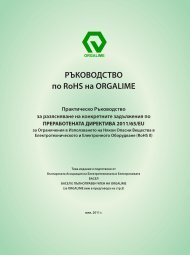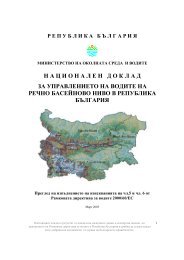Програма на научната конференция - Министерство на ...
Програма на научната конференция - Министерство на ...
Програма на научната конференция - Министерство на ...
- No tags were found...
You also want an ePaper? Increase the reach of your titles
YUMPU automatically turns print PDFs into web optimized ePapers that Google loves.
MONITORING OF VASCULAR PLANTS IN BULGARIA –METHODOLOGYCh. Gussev, D. Dimitrova, S. TzonevaInstitute of Botany, BAS, Acad. Georgi Bonchev Street, Bl. 23, Sofia 1113;E-mail: chgussev@bio.bas.bg, desco@bio.bas.bg, sonya@bio.bas.bgThe monitoring of vascular plants as an element of the Bulgarian biodiversity isrequired by the international conventions (Convention on Biological Diversity,Berne Convention, CITES), Habitat Directive (92/43/ЕЕС) as well as theBulgarian Biodiversity Act. The elaboration of the National System for Monitoringof Biological Diversity (NSMBD) of Bulgaria in 2004-2005 has marked thebeginning of the systematic observation of the state and trends of certain groups oforganisms as well as the habitats in the country. Bulgarian vascular flora (sporeand seed plants) counts up to 3900 species of 906 genera belonging to 159families. The endemic taxa are 466 (11.9%), while the relics are about 8% of thetotal number of vascular plants. The list of ferns and angiosperms that will besubject to the NSMBD includes 194 species of 63 families. Out of them, 192 are inthe National Red List, 100 are “Critically Endangered” (CR), 72 “Endangered”(EN), 15 “Vulnerable” (VU), 4 “Nearly Threatened” (NT) and 1 “LeastConcerned” (LC). Annex 3 of the National Biodiversity Act includes 170 species;16 species are in Annex 2 of the Habitat Directive. Forty-six species are in theIUCN Red List and 41 are in Berne Convention.49БИОРАЗНООБРАЗИЕ И ПРИРОДОЗАЩИТЕН СТАТУС НАOPILIONES (ARACHNIDA) OT ВЛАЖНА ЗОНА КЕРКИНИ(СЕВЕРНА ГЪРЦИЯ)П. Митов 1 , Г. Рамел 21 СУ „Св. Кл. Охридски”, Биологически факултет, катедра Зоология иантропология, бул. „Драган Цанков” 8, 1164 София, България.e-mail: pl_mitov@yahoo.com; 2 Център по Екотуризъм, Литотопос,TK 624 00, Серон, Гърция. e-mail: mrgordonramel@yahoo.comВ <strong>на</strong>стоящата работа представяме резултатите от проучването <strong>на</strong> някоиаспекти <strong>на</strong> опилионид<strong>на</strong>та фау<strong>на</strong> <strong>на</strong> гръцкия природен резерват, свързан сезерото Керкини, известен като влаж<strong>на</strong> зо<strong>на</strong> Керкини. Езерото Керкини еизкуствено и е създадено през 1932 г. <strong>на</strong> река Струма. Разположено е южноот българо-гръцката ни граница и е <strong>на</strong> 80 км северно от Солун. Райо<strong>на</strong> <strong>на</strong>езерото първо<strong>на</strong>чално е представлявал вътреш<strong>на</strong> делта, едно огромно блато,което като влажен хабитат е уникален за Европа. По<strong>на</strong>стоящем е място отекологич<strong>на</strong>та мрежа НАТУРА 2000, което е под закрилата <strong>на</strong>Между<strong>на</strong>род<strong>на</strong>та Рамсарска конвенция за опазване <strong>на</strong> влажните зони. Отизследвания район бяха установени 17 вида опилиони (един от тях бешеопределен само до род).148
















